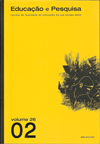How to make democratic schools?
DOI:
https://doi.org/10.1590/S1517-97022000000200005Keywords:
Democratic school, Participation, Dialogue, Classroom AssemblyAbstract
In order to answer the question in the title of this article, a journey was carried out, what made us, in first place, to define what is understood by democratic school, what are its main limitations and errors, and what are its possibilities as an instrument of social changes. The democratic school has distinguished itself as a locus of participation that has, however, frequently produced inequality and discrimination. In spite of that, democratic schools must be spaces for controversy and fight for democracy. In second place, the article makes a brief review of some of the main trends and moments of the development of democratic schools. Then, in its final part, the text proposes a set of pedagogical dynamics that should help to build schools as democratic communities. Dynamics such as meetings, the use of small groups, the definition of spaces for dialogue and participation, and the design of value practices. Finally, the author concludes describing one of the essential practices of democratic schools: classroom assembly. Apart from the description of these assemblies and how they are supposed to work, their role is also analyzed both as an instrument of values education and as a preparation for citizenship.Downloads
Download data is not yet available.
Downloads
Published
2000-12-01
Issue
Section
Focus on: Ethics and Education
License
Authors assume exclusive responsibility for the concepts expressed in their articles, which do not necessarily reflect the journal’s opinion.
Permission to photocopy all or part of the material published in the journal is granted provided that the original source of publication be assigned.
How to Cite
How to make democratic schools? . (2000). Educação E Pesquisa, 26(2), 55-59. https://doi.org/10.1590/S1517-97022000000200005



